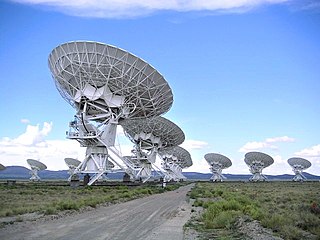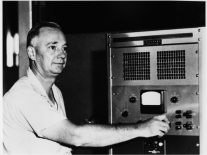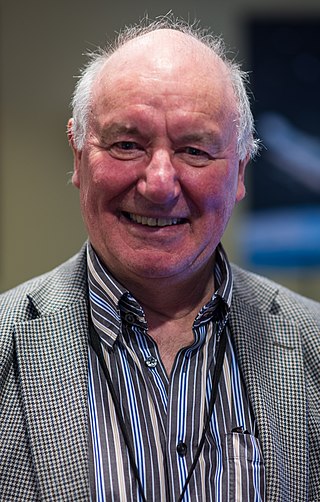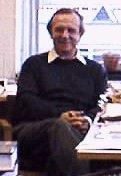
Sir Fred Hoyle (24 June 1915 – 20 August 2001) was an English astronomer who formulated the theory of stellar nucleosynthesis and was one of the authors of the influential B2FH paper. He also held controversial stances on other scientific matters—in particular his rejection of the "Big Bang" theory (a term coined by him on BBC Radio) in favor of the "steady-state model", and his promotion of panspermia as the origin of life on Earth. He spent most of his working life at St John's College, Cambridge and served as the founding director of the Institute of Theoretical Astronomy at Cambridge.

Radio astronomy is a subfield of astronomy that studies celestial objects at radio frequencies. The first detection of radio waves from an astronomical object was in 1933, when Karl Jansky at Bell Telephone Laboratories reported radiation coming from the Milky Way. Subsequent observations have identified a number of different sources of radio emission. These include stars and galaxies, as well as entirely new classes of objects, such as radio galaxies, quasars, pulsars, and masers. The discovery of the cosmic microwave background radiation, regarded as evidence for the Big Bang theory, was made through radio astronomy.

Riccardo Giacconi was an Italian-American Nobel Prize-winning astrophysicist who laid down the foundations of X-ray astronomy. He was a professor at the Johns Hopkins University.

The Cavendish Laboratory is the Department of Physics at the University of Cambridge, and is part of the School of Physical Sciences. The laboratory was opened in 1874 on the New Museums Site as a laboratory for experimental physics and is named after the British chemist and physicist Henry Cavendish. The laboratory has had a huge influence on research in the disciplines of physics and biology.

Antony Hewish was a British radio astronomer who won the Nobel Prize for Physics in 1974 for his role in the discovery of pulsars. He was also awarded the Eddington Medal of the Royal Astronomical Society in 1969.

Grote Reber was an American pioneer of radio astronomy, which combined his interests in amateur radio and amateur astronomy. He was instrumental in investigating and extending Karl Jansky's pioneering work and conducted the first sky survey in the radio frequencies.

Joseph Hooton Taylor Jr. is an American astrophysicist and Nobel Prize laureate in Physics for his discovery with Russell Alan Hulse of a "new type of pulsar, a discovery that has opened up new possibilities for the study of gravitation."

Eleanor Margaret Burbidge, FRS (née Peachey; 12 August 1919 – 5 April 2020) was a British-American observational astronomer and astrophysicist. In the 1950s, she was one of the founders of stellar nucleosynthesis and was first author of the influential B2FH paper. During the 1960s and 1970s she worked on galaxy rotation curves and quasars, discovering the most distant astronomical object then known. In the 1980s and 1990s she helped develop and utilise the Faint Object Spectrograph on the Hubble Space Telescope. Burbidge was also well known for her work opposing discrimination against women in astronomy.

Dame Susan Jocelyn Bell Burnell is an astrophysicist from Northern Ireland who, as a postgraduate student, discovered the first radio pulsars in 1967. The discovery eventually earned the Nobel Prize in Physics in 1974; however, she was not one of the prize's recipients.

John Norris Bahcall was an American astrophysicist and the Richard Black Professor for Astrophysics at the Institute for Advanced Study. He was known for a wide range of contributions to solar, galactic and extragalactic astrophysics, including the solar neutrino problem, the development of the Hubble Space Telescope and for his leadership and development of the Institute for Advanced Study in Princeton.
Aperture synthesis or synthesis imaging is a type of interferometry that mixes signals from a collection of telescopes to produce images having the same angular resolution as an instrument the size of the entire collection. At each separation and orientation, the lobe-pattern of the interferometer produces an output which is one component of the Fourier transform of the spatial distribution of the brightness of the observed object. The image of the source is produced from these measurements. Astronomical interferometers are commonly used for high-resolution optical, infrared, submillimetre and radio astronomy observations. For example, the Event Horizon Telescope project derived the first image of a black hole using aperture synthesis.

PSR B1919+21 is a pulsar with a period of 1.3373 seconds and a pulse width of 0.04 seconds. Discovered by Jocelyn Bell Burnell on 28 November 1967, it is the first discovered radio pulsar. The power and regularity of the signals were briefly thought to resemble an extraterrestrial beacon, leading the source to be nicknamed LGM, later LGM-1.

The Mullard Radio Astronomy Observatory (MRAO) is located near Cambridge, UK and is home to a number of the largest and most advanced aperture synthesis radio telescopes in the world, including the One-Mile Telescope, 5-km Ryle Telescope, and the Arcminute Microkelvin Imager. It was founded by the University of Cambridge and is part of the Cambridge University, Cavendish Laboratories, Astrophysics Department.
The Cavendish Astrophysics Group is based at the Cavendish Laboratory at the University of Cambridge. The group operates all of the telescopes at the Mullard Radio Astronomy Observatory except for the 32m MERLIN telescope, which is operated by Jodrell Bank.

The One-Mile Telescope at the Mullard Radio Astronomy Observatory (MRAO), Cambridge, UK is an array of radio telescopes designed to perform aperture synthesis interferometry.

Malcolm Sim Longair is a British physicist. From 1991 to 2008 he was the Jacksonian Professor of Natural Philosophy in the Cavendish Laboratory at the University of Cambridge. Since 2016 he has been Editor-in-Chief of the Biographical Memoirs of Fellows of the Royal Society.
The Cambridge Interferometer was a radio telescope interferometer built by Martin Ryle and Antony Hewish in the early 1950s to the west of Cambridge. The interferometer consisted of an array of 4 fixed elements to survey the sky. It produced the two Cambridge catalogues of radio sources, discovering some of the most interesting astronomical objects known. The telescope was operated by the Radio Astronomy Group of Cambridge University.

John Evan Baldwin FRS was a British astronomer who worked at the Cavendish Astrophysics Group from 1954. He played a role in the development of interferometry in Radio Astronomy, and later astronomical optical interferometry and lucky imaging. He made the first maps of the radio emission from the Andromeda Galaxy and the Perseus Cluster, and measured the properties of many active galaxies. In 1985 he performed the first Aperture Masking Interferometry observations, and then led the construction and operation of the Cambridge Optical Aperture Synthesis Telescope, and helped develop the lucky imaging method. In 2001 he was awarded the Jackson-Gwilt Medal for his technical contributions to the fields of interferometry and aperture synthesis.
The Long Michelson Interferometer was a radio telescope interferometer built by Martin Ryle and co-workers in the late 1940s beside a rifle range to the west of Cambridge, England. The interferometer consisted of 2 fixed elements 440m apart to survey the sky using Earth rotation. It produced the Preliminary survey of the radio stars in the Northern Hemisphere at 45 MHz - 214 MHz. The telescope was operated by the Radio Astronomy Group of Cambridge University.

John Ashworth Ratcliffe CB CBE FRS was an influential British radio physicist.
















